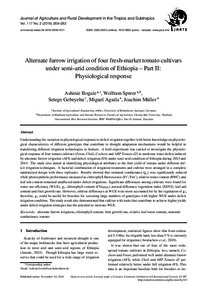| dc.date.accessioned | 2016-11-14T14:57:06Z | |
| dc.date.available | 2016-11-14T14:57:06Z | |
| dc.date.issued | 2016-11-14 | |
| dc.identifier.issn | 1612-9830 | |
| dc.identifier.issn | 2363-6033 | |
| dc.identifier.uri | urn:nbn:de:hebis:34-2016100451011 | |
| dc.identifier.uri | http://hdl.handle.net/123456789/2016100451011 | |
| dc.language.iso | eng | |
| dc.publisher | Kassel University Press | ger |
| dc.rights | Urheberrechtlich geschützt | |
| dc.rights.uri | https://rightsstatements.org/page/InC/1.0/ | |
| dc.subject | alternate furrow irrigation | eng |
| dc.subject | chlorophyll content | eng |
| dc.subject | fruit growth rate | eng |
| dc.subject | relative leaf water content | eng |
| dc.subject | stomatal conductance | eng |
| dc.subject | tomato | eng |
| dc.subject.ddc | 630 | |
| dc.title | Alternate furrow irrigation of four fresh-market tomato cultivars under semi-arid condition of Ethiopia – Part II: Physiological response | eng |
| dc.type | Aufsatz | |
| dcterms.abstract | Understanding the variation in physiological response to deficit irrigation together with better knowledge on physiological characteristics of different genotypes that contribute to drought adaptation mechanisms would be helpful in transferring different irrigation technologies to farmers. A field experiment was carried to investigate the physiological response of four tomato cultivars (Fetan, Chali, Cochoro and ARP Tomato d2) to moderate water deficit induced by alternate furrow irrigation (AFI) and deficit irrigation (DI) under semi-arid condition of Ethiopia during 2013 and 2014. The study also aimed at identifying physiological attributes to the fruit yield of tomato under different deficit irrigation techniques. A factorial combination of irrigation treatments and cultivar were arranged in a complete randomized design with three replicates. Results showed that stomatal conductance (g_s) was significantly reduced while photosynthetic performance measured as chlorophyll fluorescence (Fv’/Fm’), relative water content (RWC) and leaf ash content remained unaffected under deficit irrigations. Significant differences among cultivars were found for water use efficiency (WUE), g_s, chlorophyll content (Chl_SPAD), normal difference vegetation index (NDVI), leaf ash content and fruit growth rate. However, cultivar differences in WUE were more accounted for by the regulation of g_s, therefore, g_s could be useful for breeders for screening large numbers of genotypes with higher WUE under deficit irrigation condition. The study result also demonstrated that cultivar with traits that contribute to achieve higher yields under deficit irrigation strategies has the potential to increase WUE. | eng |
| dcterms.accessRights | open access | |
| dcterms.bibliographicCitation | In: Journal of Agriculture and Rural Development in the Tropics and Subtropics. Kassel : Kassel University Press. - Vol. 117, No. 2 (2016), S. 269-282 | |
| dcterms.creator | Bogale, Ashinie | |
| dcterms.creator | Spreer, Wolfram | |
| dcterms.creator | Gebeyehu, Setegn | |
| dcterms.creator | Aguila, Miguel | |
| dcterms.creator | Müller, Joachim | |
| dc.description.everything | Gedruckte Ausg. im Verlag Kassel Univ. Press (www.upress.uni-kassel.de) erschienen. | ger |

